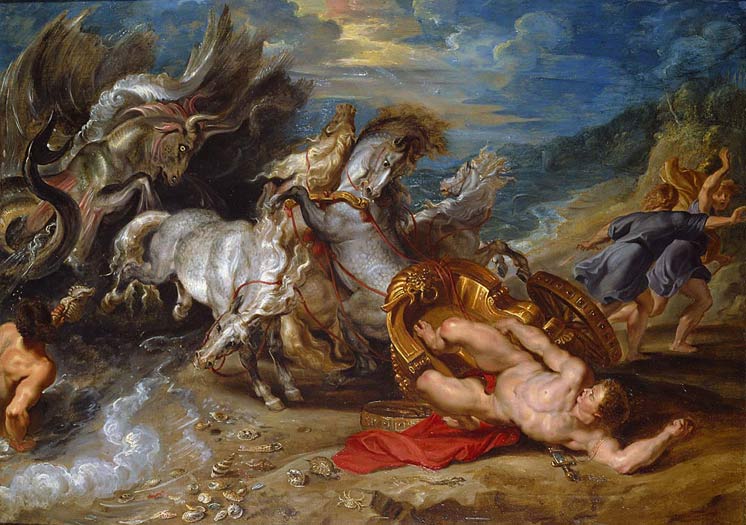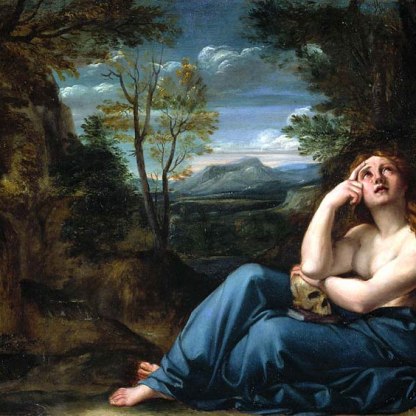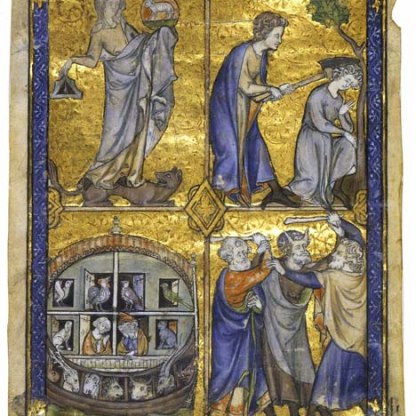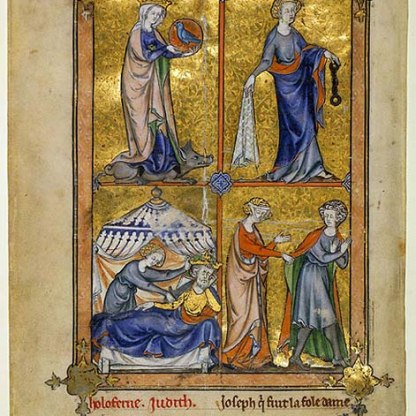The Death of Hippolytus

This small painting, by the great Flemish artist, diplomat and intellectual Sir Peter Paul Rubens, is a masterpiece of controlled chaos.
The subject is the death of Hippolytus, son of the Greek hero Theseus. After being falsely accused of attempting to rape his stepmother, Phaedra, Hippolytus is cursed and banished by his father. The sea-god Poseidon sends a monstrous bull from the depths of the ocean which terrifies the young man's chariot team and causes the bloody and fatal accident that we see here. Hippolytus, whose name means ‘loosed horse',tragically lives up to his name.
Rubens’ sea monster, with its webbed hooves, piercing yellow eye, horns and twisting, thrashing tail is a fabulous and fearsome beast.
But just as striking is the dappled horse that rears up in the middle of the picture, staring down at his prone master. It is this animal’s bulging eye that gives the painting its emotional centre and expresses the true horror of the scene. It glares with an almost human look of indignation towards Hippolytus, who can only stare feebly back from the ground. The traditional positions of charioteer and horse have been dramatically reversed.
Three more horses surround this rearing animal. Flowing manes reflect the breaking waves. The chariot team is frenzied, pulling in every direction. The horse at the left kicks out frantically with its hind legs. The two in the middle collide like waves breaking against one another. Elsewhere the laws of nature are reversed: dark clouds have turned day into night; crabs, coral and crustacea have been churned up from the ocean bed onto dry land.
The shadow that falls onto his robe beneath his left thigh suggests that Hippolytus has either yet to make contact with the ground or has bounced up, having smashed into it already. The red robe spilling beneath him anticipates the blood that shall soon flow. His sword, half unsheathed, lies impotently beneath him.
Rubens, who had returned from Italy shortly before painting this work, based the prone, muscular figure of Hippolytus on a drawing by Michelangelo now in the Royal Collection, Windsor Castle, left. This depicts another classical myth: the punishment of the giant Tityus in Hades, whose liver was daily devoured by a vulture.

A drawing by Rubens in the Fitzwilliam, Abel slain by Cain, PD.43-1961, also has much in common with the figure of Hippolytus here.
At the left of the painting, a sea-god blows his conch, a decorative addition to the story. It has been suggested that this conch and the shells in the foreground, which are themselves notable as still-life studies, may have reflected the collecting interests of whoever commissioned the work. Such exotic marine curiosities were much sought after in the period. A late sixteenth-century cup in the Fitzwilliam M/P.4-1938, is made up of a nautilus shell, enriched with gilt fittings.
Themes and periods
Data from our collections database
Bryan, c. 1796; Duke of Bedford, Sale, Christie's, 1951; Lord Plunket
Legal notes
Accepted by HM Treasury in lieu of estate duty and allocated to the Fitzwilliam Museum, 1979
Acquisition and important dates
- Method of acquisition: Allocated
- Dates: 1979
Dating
Maker(s)
- Rubens, Peter Paul Painter
Materials used in production
Read more about this recordStories, Contexts and Themes
Other highlight objects you might like
Suggested Curating Cambridge products
Sign up to our emails
Be the first to hear about our news, exhibitions, events and more…






